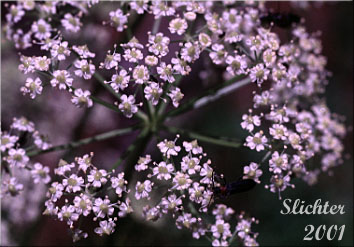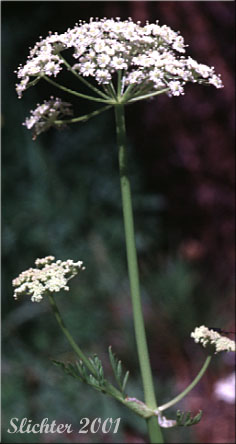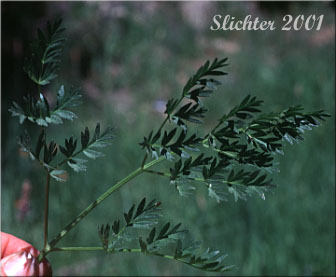[Licorice-roots and Lovages: The Genus Ligusticum in the Columbia River Gorge of Oregon and Washington]
Gray's Licorice-root, Gray's Lovage, Sheep Wild Lovage
Ligusticum grayi
Synonyms: Ligusticum apiifolium var. minus, Ligusticum caeruleomontanum, Ligusticum cusickii, Ligusticum purpureum, Ligusticum tenuifolium var. dissimilis, Pimpinella apidora var. nudicaulis
 A close-up of the umbel of Gray's lovage from Cheatem Holler,
Rds #31 & #37, Malheur N.F..........June 27, 2001.
A close-up of the umbel of Gray's lovage from Cheatem Holler,
Rds #31 & #37, Malheur N.F..........June 27, 2001.
 The
photo at right shows a side view of the umbel of Gray's lovage from Cheatem
Holler, Rds #31 & #37, Malheur N.F..........June 27, 2001.
The
photo at right shows a side view of the umbel of Gray's lovage from Cheatem
Holler, Rds #31 & #37, Malheur N.F..........June 27, 2001.
Characteristics:
Gray's lovage is an erect perennial with one
to several stems arising 20-60 cm high. The herbage is glabrous and the leaves
are mainly basal. The stems are often leafless or may have one or two much
reduced leaves. The leaves are pinnately-compound with much dissected margins.
The leaflets are up to 3 cm long and are toothed or cleft. The plants are
aromatic.
The 1-3 umbels are found at the apex of the stem
or arising from the base of the upper stem leaves. The 7-14 rays of the umbel
range from 2-3.5 cm long at maturity. The fruit are elliptic-oblong in shape
and range from 4-6 mm long. The ribs of the fruit are narrowly winged.
The roots were once pulverized and used as a
fish poison. Some Native Americans cooked the young leaves.
Habitat:
Gray's lovage may be found on moist to dry slopes
both in open meadows or on wooded slopes in the mountains.
Range:
Gray's lovage may be found from the Cascade Mts.
of Washington south to the Sierra Nevada of California and east to the Blue
Mts. of northeaster Oregon and Washington and into western Idaho and Nevada.
In the Columbia River Gorge, Gray's lovage may
be found between the elevations of 3000'-4500' from from east of Crown Point
to Mt. Defiance.

A basal leaf of Gray's lovage from Cheatem Holler, Rds #31 &
#37, Malheur N.F..........June 27, 2001.
Paul Slichter


